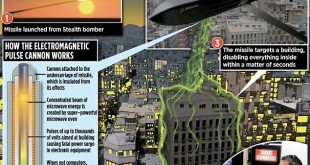Introduction
The United States Defense Advanced Research Projects Agency (DARPA) has taken a significant step forward with its Macaroni project, issuing a broad agency announcement that calls for the development of groundbreaking RF receivers, transmitters, and antennas. This ambitious initiative aims to revolutionize RF and microwave technology, propelling communication and sensing systems to unprecedented heights for defense applications.
These components are expected to outperform today’s standards while conquering the well-known limitations posed by the Chu Limit, which restricts the bandwidth achievable with small antennas.
These antennas, often referred to as “electrically small antennas,” are much smaller in size than the wavelength of the electromagnetic radiation they handle. This size disparity triggers a series of challenges that impact their efficiency and bandwidth. When the antenna’s size becomes a significant fraction of the wavelength, energy tends to be stored and re-radiated inefficiently, leading to narrower bandwidths and reduced performance.
The project’s objectives reflect a growing need for compact, efficient technologies that defy traditional constraints. By overcoming the constraints posed by the Chu Limit, DARPA seeks to unlock a range of advantages that could reshape the capabilities of modern military operations.
Breaking Free from the Chu Limit
Electrically small antennas, essential components of RF receivers and transmitters, have long been shackled by the Chu Limit. Named after physicist Tai Tsun Wu (Chu), this limit has curtailed antenna design and performance. Classical antenna theory has long established that the sensitivity-bandwidth product is closely tied to the size and shape of an antenna.
In essence, it forces a trade-off between antenna sensitivity and bandwidth, leading to less efficient communication. However, modern requirements demand that these components transcend conventional boundaries to support size-, weight-, and power-constrained applications.
Recent Breakthroughs: A Game Changer
In the realm of transmitters, innovations in active antenna technology, control schemes, impedance-matching methods, and volume-filling strategies are unlocking new possibilities. Materials like piezoelectrics, magnetoelectrics, high-index materials, and multiferroic materials offer opportunities to enhance efficiency in small antennas.
- Metamaterial Marvels: Advanced materials, such as metamaterials, possess distinctive electromagnetic properties that redefine how antennas interact with electromagnetic waves. These materials offer the promise of making smaller antennas perform on par with larger ones, effectively boosting bandwidth and efficiency.
- Quantum Leap: Quantum sensors, renowned for their exceptional precision, have the potential to vastly enhance the sensitivity of RF systems. By integrating quantum sensors into RF receivers and transmitters, it becomes possible to extract more information from the received signals, compensating for the limitations imposed by the Chu Limit. Leveraging these sensors can lead to elevated data rates and more precise signal processing, even when navigating the limitations of the Chu Limit.
- Shielding Against Interference: Techniques in electromagnetic shielding are poised to minimize interference and noise in communication systems. This translates to clearer signals and elevated communication quality, particularly in demanding conditions.
- Resonance Redefined: Innovative designs for resonators and metamaterial structures are redefining the management of electromagnetic waves. These structures empower antennas to function more effectively within their size confines, resulting in improved bandwidth and sensitivity.
- Miniaturized Electronics: The development of smaller, more efficient electronics has enabled the creation of compact RF transceivers and antennas. As electronics continue to shrink, it becomes feasible to design integrated antenna systems that can operate at higher frequencies and achieve better performance within limited size constraints.
Program
The Macaroni program unfolds in three phases over 45 months, starting in February 2024. The three phases encompass an 18-month initial phase, an 18-month intermediate phase, and a nine-month concluding phase. These phases are centered on two primary technical areas: receivers and transmitters. Receiver work revolves around enhancing receive sensitivity, link closure, and system integration. In contrast, transmitter efforts focus on amplifying transmitter strength, demonstrating a functional transmitter system, and ensuring system ruggedization.
The Macaroni project embodies a multi-disciplinary approach, recognizing that the challenge of conquering the Chu Limit requires collaboration across various scientific domains. Physics, electrical engineering, materials science, and computer modeling converge to tackle this complex problem from different angles, each contributing to the holistic solution.
Military Advantages Unleashed
The ripple effects of DARPA’s Marconi project could usher in a host of strategic advantages for military applications:
- Efficiency Amplification: The breakthroughs could lead to more efficient communication systems, expediting data transmission and enhancing overall efficiency.
- Robust Signaling: Surpassing design limits equips systems to uphold strong communication, even in challenging conditions, bolstering situational awareness and response capabilities.
- Expanded Reach: By pushing the boundaries of antenna performance, systems can extend coverage over larger areas, enhancing capabilities for surveillance and intelligence gathering.
- Compact Devices: Miniaturization takes center stage, resulting in smaller and lighter devices ideal for confined spaces, including drones and wearable technology.
- Stealth Empowerment: Reduced electromagnetic signatures enhance stealth capabilities, enabling covert operations and electronic warfare with diminished detection risk.
- Accelerated Data: Increased data rates facilitate swift transmission of vital information, such as real-time battlefield updates and high-resolution imagery.
- Adaptability Amplified: The flexibility to operate across different frequency bands equips systems to navigate contested electromagnetic environments.
- Elevated Sensor Performance: Beyond communication, sensor capabilities could experience a significant boost, amplifying detection, tracking, and intelligence collection.
- Swift Connectivity: Rapid deployment of communication networks becomes a reality, heightening connectivity among units, even in remote locales.
- Pioneering the Way: By conquering design challenges, military forces establish themselves as leaders in technological innovation, reinforcing national security.
Conclusion
DARPA’s Marconi project embarks on a journey with the potential to revolutionize military communication and sensing capabilities. By surmounting the Chu Limit and harnessing advanced technologies, the project offers a glimpse into a future where technology empowers forces with unparalleled capabilities and resilience.
 International Defense Security & Technology Your trusted Source for News, Research and Analysis
International Defense Security & Technology Your trusted Source for News, Research and Analysis

